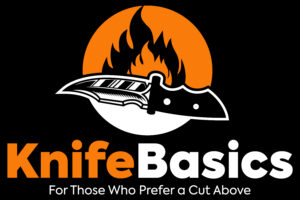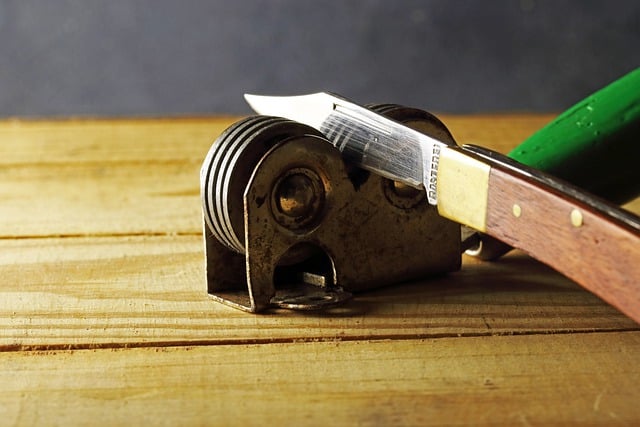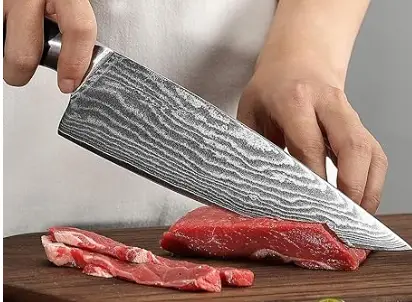What is CPM REX 121?
What does this mean for knife users? Blades made from this steel offer excellent wear resistance, edge retention and are consequently difficult to sharpen.
Although it offers the best edge retention, many knife makers do not use this steel because it is difficult to grind, is brittle, and is very difficult to sharpen.
CPM 121 REX is used in cold forming, fine blanking, dry cutting tools, and knife making. To understand more details about this steel, come with us to the next section to discuss the properties in detail.
CPM REX 121 Steel Composition
- Carbon C 3.40%: Increases the edge retention, hardness and tensile strength. It also improves steel resistance to wear, abrasion and corrosion.
- Chromium Cr 4.00%: Formation of Chromium carbides Increases hardness, tensile strength and toughness of the blade.
- Molybdenum Mo 5.00%: It improves machinability and hardness.
- Vanadium V 9.50%: Increase wear resistance and toughness, it also improves corrosion resistance. High vanadium content enables formation of Vanadium Carbides.
- Cobalt Co 9.00%: Improves hardness of the blade as it increases the martensitic transformation temperature of the alloy, It also increases corrosion resistance of steel.
- Tungsten W 10.00% Improves wear resistance and hardness, mostly added to tool steel
- Sulfur S 0.03%: helps improve machinability and grindability.
Properties of CPM REX 121 steel
REX 121 Steel Hardness
CPM REX 121 is a super hard steel with its hardness ranging from 70-71HRC. The extreme hardness of this steel is associated with the high amounts of Cobalt and Vanadium, which form high carbides.
REX 121 Steel Edge Retention
One of the areas of excellence for REX-121 is its edge retention, which is associated with high hardness. Blades made from this steel hold a sharp edge for the longest time, irrespective of the frequency of use.
Because of this property, this steel is used to make Everyday Carry (EDC) knives. The blades can handle everyday cutting activities without becoming dull.
If you are out in the market searching for an EDC knife that will not require you to keep on sharpening, look into the varieties of REX 121 knives.
REX 121 Steel Wear Resistance
Because of its extreme hardness, REX 121 offers excellent wear resistance. This steel can resist material loss that leads to wear even with frequent usage and sharpening. If well maintained, REX 121 knives can be used across generations.
REX 121 Steel Toughness
The hardness and toughness of steel lie in opposite ends. Most steels offer either high hardness or high toughness but not both because increasing one decreases the other.
Therefore, because of its extreme hardness, the toughness of REX 121 is poor. This means that blades made from this steel will break and chip easily when used for demanding applications like batoning or prying.
REX 121 Steel Corrosion Resistance
Another downside of REX 121 is that it is not stainless steel. Therefore it is easily susceptible to rusting. Knives made from this steel cannot be used in corrosive environments because they rust and stain easily.
Proper care and maintenance are essential to keep REX 121 knives from rusting. Ensure to wash and dry them after use.
Before taking knives made from Rex 121 steel home because of the excellent edge retention, consider the non-stainless property and only continue with the purchase if you can take proper care.
Sharpening Rex 121 Steel
The ability to get a razor-sharp edge is an important consideration when purchasing knives. The ease of sharpening steel is directly affected by the hardness and wear resistance. Sharpening REX 121 is very difficult, thanks to its extreme hardness and wear resistance.
Very few people have the patience and skill to sharpen this steel. Also, it is capable of damaging standard abrasives. To sharpen blades made from this steel, you need hard abrasives like diamond sharpeners.
You will probably be drawn to knives made from this steel because they stay for long without getting dull, but unfortunately, getting a back a sharp edge after it becomes dull is a challenging task.
CPM Rex 121 Steel Comparison
Rex 121 vs Maxamet
Both Rex 121 steel and Maxamet steel are super hard steel above the 68HRc range. Maxamet is non-stainless steel produced by Carpenter, while Rex 121 is from Crucible.
Rex 121 is harder than Maxamet, but both will offer extreme wear resistance and edge retention. No steel compares to this two when it comes to edge retention and wear resistance.
In terms of toughness, Maxamet steel will offer slightly more toughness than Rex 121. Both are comparable, and the difference is almost negligible.
They are not the best in corrosion resistance as they are not stainless. Maxamet will provide a bit better corrosion resistance. Their corrosion resistance is significantly lower than other non-stainless steel like CPM 3V and CruWear Steel.
Sharpening these knife steels is a pain-staking process; they require highly skilled personnel and sophisticated sharpeners with high hardness.
Rex 121 vs S110V
Rex 121 and S110V steel offer high Rockwell hardness, Rex 121 though offers more at about 71 HRc while S110V at about 66 HRc. Rex 121 blade steel beats S110V blade steel in edge retention as hardness directly impacts edge retention. Regarding toughness, S110V steel beats Rex 121 due to a better alloy geared towards a more balanced approach of hardness and toughness.
S110V is stainless steel with about 15.25% chromium elements, offers better corrosion resistance than non-stainless Rex 121 at about 4.00% chromium elements. S110V corrosion resistance is among the best in knife steel; it is on par with M390 steel, CTS 204P steel, and 20CV.
Generally, S110V knife steel is better than Rex 121 as it offers balanced performance across the board and is easier to sharpen.
Rex 121 vs Rex 45
Rex 121 and Rex 45 are super high-speed steels with a combination of Vanadium and Cobalt in their alloys to improve their performance. Rex 45 has low amounts of Vanadium and Cobalt in its alloy compared to Rex 121. It thus offers a reduced Hardness of about 67 HRC.
The reduced hardness allows for tougher steel that is less brittle than the high hardness Rex 121. Rex 121 steel will beat Rex 45 in edge retention. However, Rex 45 will provide about four times the toughness level of Rex 121.
Both are not stainless steel; however, CPM Rex 45 has reduced carbon with a bit more chromium than Rex 121, thus providing better corrosion resistance.
In terms of ease of sharpening, it will be much easier to sharpen Rex 45 due to the reduced hardness and wear resistance. Rex45 makes better knife steel than Rex 121, primarily focused on edge retention.
Also Read: S125V steel review, a stainless steel with high hardness and edge retention



